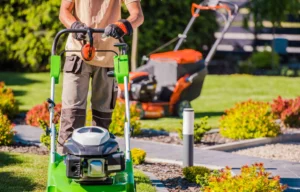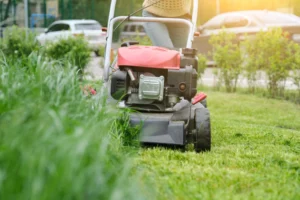Many homeowners see mowing their lawns as an unpleasant chore. At the same time, it is a weekly ritual for most lawn owners, who view it as a chance to beautify their property. But do you know how to mow a lawn the proper way?
Even if you feel you know how to mow a lawn, certain situations may need a little relearning. Maybe you just got a new home with a problematic and unhealthy yard, or perhaps this spring brought you some wild and unexpected grass growth. No matter your situation, you’ll want to know how to mow your lawn safely and quickly.
Lawn mowing is vital in keeping your grass green and healthy and also helps in reducing weeds and bare spots. This guide will help you to learn how to mow a lawn like a pro.
Why Mow a Lawn?
Mowing your lawn is a blessing in disguise. It is a technique of showing some love to your yard. Mowing promotes grass growth by promoting photosynthesis. It is a process where the grass pulls in energy from the sun, water from the earth, and carbon dioxide from the air to grow its roots and blades.
When you cut off the grass tips, they stimulate further growth. Mowing your lawn regularly results in a thicker lawn with better roots, eliminating weeds and making your turf pleasant enough to toss a ball on and roll around.
How to Mow a Lawn?

If you have a vast spread-out lawn, you may feel like the more you mow, the more it grows. But keeping your yard neatly maintained is a must for optimal curb appeal.
But where do you start? Whether you’re a mowing pro or this is your first time behind a mower, follow these tips to increase the health and wellness of your lawn and get that enchanting green look you’ve always wanted.
Follow these simple steps when you next mow your lawn:
Step 1: Choose the right lawnmower
It’s all about having the proper tools for the job. Picking the right lawnmower depends mainly on your lawn size.
Consider investing in a riding mower for more extensive lawns (say, more than a quarter acre in size). An electric or gas-powered front-wheel-drive walk mower can often tackle smaller lawns. You can also use a low-cost push mower if you have a tiny yard.
If you want to turn your clippings into free lawn food, choose a mower with a “3-in-1” mulching blade. You can add a lawnmower bag to collect the clippings and throw them in a compost pile if you wish!
Step 2: Sharpen Mower Blades Regularly
If you can’t recall the last time you sharpen your mower’s blades, it’s time to do so.
Mowing with a dull blade is the worst thing you can do to a lawn. Tearing the leaf invites diseases to attack it. A clean cut helps it repair faster and become a healthy growing plant.
How frequently you need to sharpen your blade will depend mainly on how many hours of mowing it does. Mowing a large lawn will usually cause your blades to dull faster than occasional use on a small patch of turf.
How do you know if your mower’s blades are dull?
- Check if it cuts the grass evenly
- Inspect if there are chips and gaps in your blade
Step 3: Know When to Mow the Lawn

Ideally, mowing a lawn depends on the time your grass needs it. You can either do it yourself or hire a professional, but the motive is to make a schedule for lawn mowing so that it benefits your grass the most.
The mowing schedule may vary depending on the following things:
- Grass type: Every grass has its growing season. Therefore, the mowing schedule entirely depends upon the grass growing in your yard.
- Drought: It is recommended to set the mowing height higher and reduce your mowing frequency to maintain the moisture of the grass during a drought.
There is a difference in the growth patterns of various grass types.
- Warm-season (Southern) grasses ramp up their growth in the summer, so you need to mow them more frequently—for example, the St. Augustinegrass and Bermudagrass.
- Cool-season (Northern) grasses: Turf-type tall fescues, Kentucky bluegrass, and fine-leaf fescues grow in fall and spring, so that’s when your mowing activity will start.
Step 4: Know the Most Suitable Time of Day to Mow Your Lawn.
Your mowing time can greatly impact your lawn’s health.
Best times to mow: According to the professionals, mid-morning, between 8 a.m. to 10 a.m., and after 4 p.m. is the best time to mow your lawn.
Worst times to mow: Early morning, between 6 a.m. and 8 a.m, is considered the worst time for mowing as there will still be dew on the grass. The moisture makes your lawn mower work harder. This further causes clumps of wet grass to clog the mower and accumulate in your yard. Therefore it is better to wait until that dew has dried up.
In addition, avoid mowing at midday as it’s just too hot and in the evening after 6 p.m. when the grass won’t have time to recover before nightfall.
Step 5: Mowing Pattern

Once you start mowing the open lawn, it is recommended to have a pattern while mowing your lawn.
Changing your mowing pattern is better for the best curb appeal, especially if your mower is heavy. That way, you grab the blades of grass that may have bent out of the way the last time you mowed.
Select a cutting pattern and modify it each time you mow the lawn. Many find it practical and easy to start from the perimeter and work toward the center. Or you can even cut in straight lines for a patterned appearance.
Step 6: Set a Proper Height to Cut Grass
The proper height to cut your grass depends on its species. But over the years, specialists have made one important rule:
- The One-Third Rule: Avoid removing more than one-third of your grass while mowing.
It’s best to stick to the one-third rule and cut your grass accordingly. This way, you can reduce the stress put on the vegetation.
The one-third rule can be a little hard to follow. But usually, all mowers have a height adjustment feature, so use yours for better results.
Step 7: Decide what you want to do with grass clippings.
Clippings can provide vital nutrients for your lawn if you let them be. But if you want the ultimate polished look, you can sweep the clippings away or blow them away using a leaf blower.
Step 8: Relax and enjoy a job well done!
Relax, grab your favorite drink, kick back, and enjoy the view.
Some Extra Guidelines on How to Mow A Lawn

Keep weather conditions (heat, cold, drought) in mind whenever you mow. These basic guidelines for mowing heights will help you in lawn mowing.
Mowing Height for Cool-Season Grasses
Fescue: 2 to 3 inches
Bentgrass: 1/2 to 1-inch
Perennial Ryegrass: 2 to 3 inches
Kentucky Bluegrass: 2 to 2-1/2 inches
Mowing Height for Warm-Season Grasses
Bermuda: 1-1/2 to 2 inches
Bahia: 2 to 2-1/2 inches
Centipede: 1-1/2 to 2 inches
Zoysia: 1-1/2 to 2 inches
St. Augustine: 2 to 3 inches
Mow it Yourself? Or Hire a Pro! Contact the Experts at ProGreen Lawn Service Today!
Getting your lawn to look flourishing is the dream of every homeowner. We hope this article helped you figure out how to mow a lawn on your own.
However, if you don’t like mowing your lawn by yourself or feel that you have better things to do on the weekend, there’s nothing wrong with that. You can simply call up the professionals and have them mow your lawn instead.
Professionals at Pro Green Lawn Services use the best methods to mow and landscape your yard while ensuring its long-term health.
Contact us now to get a healthy environment for your turf to thrive!


